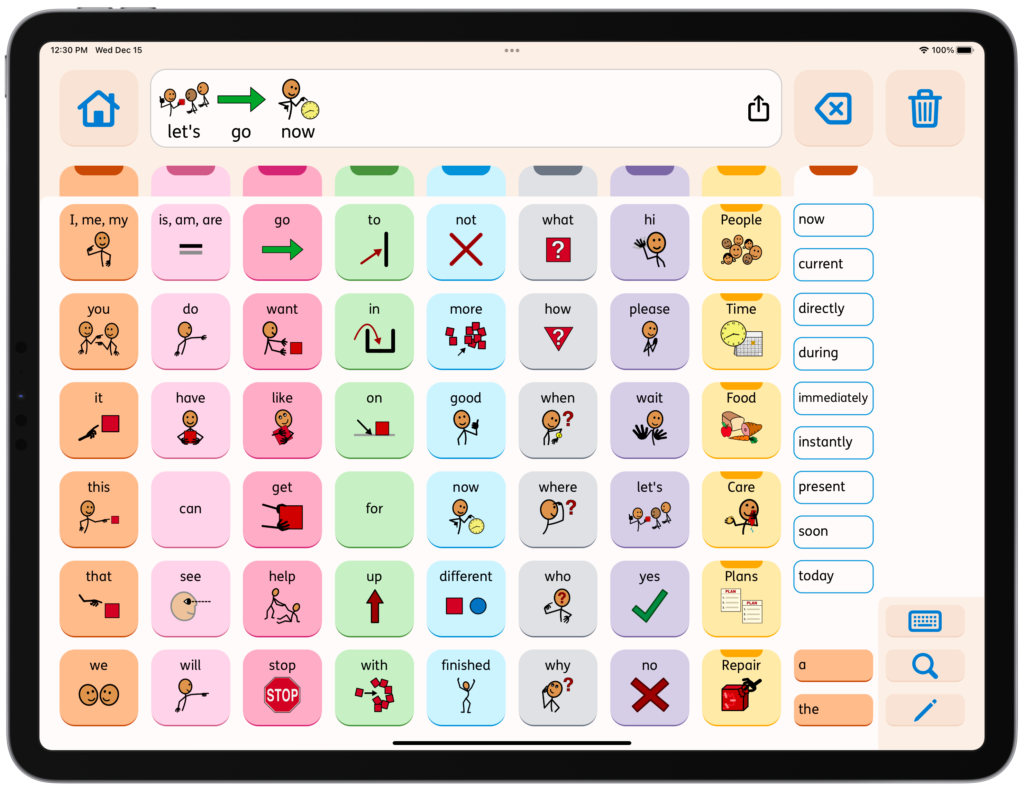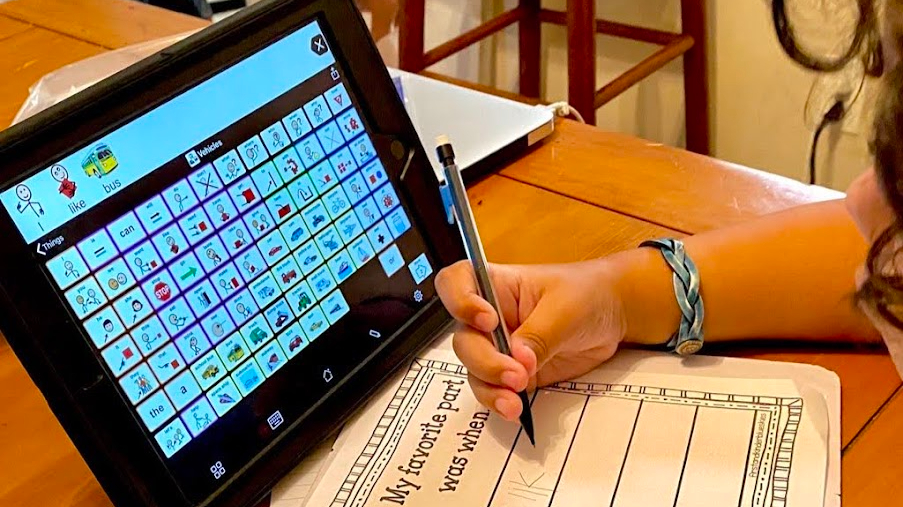AAC Devices: What They Are and How You Can Get One for Your Autistic Child
AAC stands for Augmentative and Alternative Communication. AAC includes any type of communication that is not speech – pictures, text, gestures, choice boards, body language.
This article goes over the basics of robust AAC systems (speech generating devices) and how you can get one for your autistic child.
What is an AAC Device?
The phrase AAC device sounds like something really complicated. In reality, most AAC “devices” are simply apps downloaded on an iPad or a tablet. Some of them are symbol-based (using pictures). Others are text-based (using letters). Many are multimodal (using both).
One of my children started using a symbol-based app when he was four. It’s called Proloquo2Go. As he got older, he starting to use the keyboard within the app to type. This app let him switch between the two modes easily.

Who can benefit from an AAC device?
Any child who isn’t developing speech in a typical way should have access to an AAC device. The earlier the better! The fact that doctors prescribe behavioral interventions without mentioning AAC is highly unethical in my opinion, but that’s a topic for another day.
AAC devices DO NOT hinder speech development. If anything, these devices can help children develop language more quickly than they would without using one. The overall goal for any child is to enhance communication. The more a child can communicate, the happier that child will be. Remember, communication is a human right.
When should I ask about an AAC device?
Yesterday! No, seriously. There are no prerequisite skills needed to use AAC devices. If your child can take your phone and watch YouTube or play a game, they can use an AAC device!
Note: Insurances may require a minimum age for funding, but we’ll get to that below.
If your therapist or doctor discourages you from getting your child an AAC device, you may want to find another provider. If that isn’t possible, send the provider a few links from this article. I’ve included several more down below.

How can I get an AAC device for my child?
You can work on all three options at the same time. One option is not dependent on the other. If you prefer a particular app, say that up front for options 2 and 3.
Option One: Self Pay
You can buy an iPad (or Android tablet depending on which app you choose) and download the app yourself. Make sure you get a durable case with a kickstand. That’s really all you need to get started! There are lots of free AAC apps, but most of them aren’t robust systems.
I highly recommend the new Proloquo app for children who can already navigate a tablet by playing games or watching YouTube. Proloquo comes with a free parent coaching app called Proloquo Coach. It also comes with a 1-month free trial and has options to pay $10/month instead of a large up-front cost.
Most robust AAC apps range in price from $200 – $400. Almost all of them go on sale twice a year – in April and October – usually for 50% off! (Each app sets their own sale dates during these months, so pay attention to that.) Lauren S. Enders pulls together all of the sale dates for the different apps ahead of each month-long sale.

Option Two: Ask your medical provider.
You can also get an AAC device through your child’s doctor. Most health insurances in the U.S. will cover the cost. This is the route I took for my child because I didn’t realize I could buy it myself. I thought AAC devices were actual machines that only did one thing.
Insurance companies often have minimum age requirements and proof that speech therapy ‘isn’t working.’ These requirements are unhelpful, but I want you to be aware that there may be some hurdles. DO NOT let these requirements discourage you from starting the process. The sooner you get started, the better!
If you choose this route, here’s how to do it:
- Ask your child’s doctor for a referral for an assistive technology assessment, also called an AAC assessment. You do not need to wait for your next appointment or make an additional appointment for the doctor to do this. They can simply call in the referral or fax it.
- Schedule the assessment and go. If your insurance doesn’t require referrals for specialists, you can skip number one and make the assessment appointment yourself. Some children’s hospitals have AAC clinics. Others do the assessment in their speech therapy offices.
During the appointment, the therapists will try out several systems to see which one “fits” your child best. They’ll also check to see if your child needs any add-ons like a grid guard or a mount. If you prefer a specific app, tell them so they can include it in the trial. - Getting your child’s device: While you’re at the assessment, ask questions about your options! Ask about in-network distributers and what the process will be for your specific insurance.
The process varies depending on your insurance requirements. Some insurances make it easy and mail the device right away. If you go to an AAC clinic, they may have their own way of doing it.
Unfortunately, some insurances require the child to complete a trial period with mandated training sessions using a rental device. This was the year-long process we went through. While I did find value the therapy sessions, it definitely took maximum effort to meet all the requirements.
Option 3: Getting AAC at School
If your child has an IEP, you can request an assistive technology assessment. Put the request in an email so it is documented. (Documentation is always best practices.) If you prefer them to trial a specific app, let them know in the email. This process will ensure that your child has continuous access to a device at school because it will be included in the IEP.
Pro Tip: Learn and understand your rights under IDEA Special Education Law. The US Department of Education recently released new guidance on implementing and offering assistive technology in school. Look over the Myths vs. Facts document and keep a copy to bring to your IEP meetings.
Further Reading
This article is meant to be a quick overview. You can find more information at these links:
Information on AAC ~ Therapist Neurodiversity Collective
Ask Me, I’m an AAC User: My Favorite Facebook Learning Group
What is AAC? ~AssistiveWare
All About AAC ~ Just Keep Stimming
CoughDrop is an open source AAC app that can be used on multiple platforms.
LAMP is another robust AAC
100-ish Books on Autism and Neurodiversity – There is an entire section dedicated to nonspeaking authors.
New Guidance from the US Department of Education on implementing and offering Assistive Technology in public schools


9 replies to "AAC Devices: What They Are and How You Can Get One For Your Autistic Child"
Well done!
Dad
Sent from my iPhone
[…] AAC Devices: What They Are and How You Can Get One For Your Autistic Child […]
[…] AAC Devices: What They Are and How You Can Get One For Your Autistic Child (in inglese) […]
[…] AAC Devices: What They Are and How to Get One – by Meghan Ashburn […]
Good day, I have an nonverbal autistic grand son. Please Please ,he needs a AAC device. I do no have any means to buy one, We live in South Africa. Please contact me via this mail. This is the most emotional mail that I have ever written, Begging for an educational device for Noah,. My home address is 103 Kabeljou Road, Newlands East, Durban, South Africa.. 4037. Thanking You in Anticipation. Mrs JS Moyce
[…] is a human right, and all communication is valid. Click here for more information about AAC (alternative and augmentative […]
My child speaks most of the time but has terrible anxiety when speaking with people who are not bilingual. The district did an assistive technology assessment and what a surprise!/s they found that she did not need any devices. She has trouble with processing speech and needs time to reply. I think this would be helpful to her.
Are there any apps out there for children who speak Spanish primarily? Does Proloquo offer that option?
Not yet, but Proloquo2Go does. 💜